April 14, 2017
Air Date: April 14, 2017
FULL SHOW
SEGMENTS
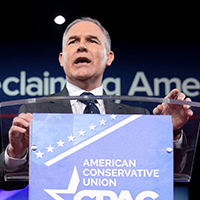
EPA Boss Under Fire from Left and Right
View the page for this story
Even before Scott Pruitt was sworn in as EPA Administrator conservation groups had a litany of complaints, but now some conservative voices are also expressing displeasure with his performance to date. Mother Jones Reporter Rebecca Leber discusses with host Steve Curwood why the former Oklahoma attorney general, who sued the EPA 14 times, is not satisfying some wish lists of conservatives. (07:45)
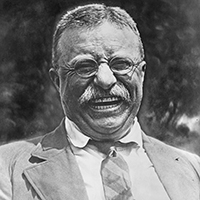
Beyond The Headlines
/ Peter DykstraView the page for this story
Peter Dykstra returns to Living on Earth this week to discuss what’s beyond the headlines with host Steve Curwood. They consider EPA chief Scott Pruitt’s decision on a pesticide and the latest legal efforts to try to stop the Dakota Access Pipeline. In the history segment, Peter shares an environmental message from a Republican president in 1907. (03:40)
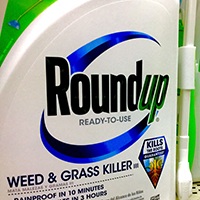
Roundup® Maker Sued Over Cancer Risks
View the page for this story
California recently added glyphosate — a chemical found in the herbicide Roundup® - to its list of chemicals to be labeled as being suspected of causing cancer. Monsanto, makers of Roundup®, maintains that glyphosate has a long history of safe use but faces dozens of lawsuits from gardeners and farm-workers who claim the weed killer caused their non-Hodgkin’s lymphoma, and documents unsealed as part of a California suit may cast doubt on some of chemical giant’s research. Environmental lawyer Robert F. Kennedy Jr., part of the plaintiffs’ litigation team, discusses the issues with host Steve Curwood. (08:30)
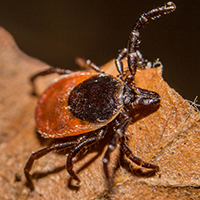
Science Note: Why Lyme Disease Thrives Up North
/ Don LymanView the page for this story
Lyme Disease-carrying ticks in the northern United States have potentially more contact with humans, while southern heat creates fewer opportunities to infect people or animals. Living on Earth’s Don Lyman explains the connection between geography and tick behavior in this week’s note on emerging science. (01:40)

Climate Change and Your Health
View the page for this story
Scientists and most Americans are concerned about climate change and its effects on our environment, economy, and society. But a growing number of US physicians see a wide gap in the public’s grasp of how global warming does, and increasingly will, affect human health. Dr. Mona Sarfaty, Director of the Medical Society Consortium on Climate and Health, joins host Steve Curwood to discuss her organization’s push to spread awareness of the changing climate’s health impacts. (07:00)

Death and Life of the Great Lakes
View the page for this story
The five mighty Great Lakes, separated from the ocean for millennia, hold twenty percent of the world’s surface freshwater. Dreams of trade spurred construction of the St Lawrence Seaway, opening the lakes to intercontinental shipping but transforming their ecosystems, thanks to unintended biological hitch-hikers such as Quagga and Zebra mussels. Environmental journalist Dan Egan’s new book, “The Death and Life of the Great Lakes”, details the changes, and he discussed the impact on the Great Lakes with host Steve Curwood. (14:25)

Purrfect for Cats and Coffee
/ Sean PowersView the page for this story
At a new Cat Café in Atlanta, you can order "espurrsso," an "Ameowicano" or a "catpuccino" -- and hang out with adoptable cats, like the vocal feline “Olivia.” Cat-lover Sean Powers of Georgia Public Broadcasting created this audio postcard. (03:55)
Show Credits and Funders
Show Transcript
HOST: Steve Curwood
GUESTS: Rebecca Leber, Robert Kennedy Jr, Mona Sarfaty, Dan Egan
REPORTERS: Don Lyman, Peter Dykstra, Sean Powers
[THEME]
CURWOOD: From Public Radio International, this is Living on Earth.
[THEME]
CURWOOD: I'm Steve Curwood. Before the new EPA Administrator Scott Pruitt took the job, he sued the Agency 14 times as Oklahoma’s Attorney General. Environmental activists were appalled but conservative commentators saw him as a powerful force to sweep away climate change regulations. Now, they’re not so sure.
LEBER: Pruitt is alienating people on the left, right, even the middle, and faced with steep budget cuts if those do come to pass, that could make his job next to impossible.
CURWOOD: Also, a visit to the cat cafe.
MAYO: There are ramps, and there are little jumper boards for the cats to go up the walls kind of diagonally one board to the next. It’s kind of a cat’s dream play-scape.
[CAT GROWLS]
Those stories and more, this week on Living on Earth. Stick around.
[NEWSBREAK MUSIC: Boards Of Canada “Zoetrope” from “In A Beautiful Place Out In The Country” (Warp Records 2000)]
[THEME]
EPA Boss Under Fire from Left and Right

Administrator of the Environmental Protection Agency Scott Pruitt speaking at the 2017 Conservative Political Action Conference (CPAC). (Photo: Gage Skidmore, Flickr CC BY-SA 2.0)
CURWOOD: From PRI, and the Jennifer and Ted Stanley Studios at the University of Massachusetts Boston, this is Living on Earth. I’m Steve Curwood.
When it comes to new top level hires for incoming Republican presidential administrations, one of the riskiest positions has to be Administrator of the Environmental Protection Agency. Anne Gorsuch, mother of the newest Supreme Court justice, came into the new anti-regulatory Reagan administration amid calls to cut the EPA budget and was gone herself within two years, thanks to blowback of a Superfund scandal.
Christine Todd Whitman, the former governor of New Jersey came into the George W. Bush Administration after campaign promises to cut carbon emissions, but when Mr. Bush pulled out of the Kyoto Climate Accord Governor Whitman was out of a job after a little more than two years.
Well now Scott Pruitt, Mr. Trump’s EPA boss, is already under fire from both sides of the aisle especially regarding carbon pollution and climate change from both sides of the aisle.
Take conservative Fox News anchor Chris Wallace, for example. On April 9, he challenged Mr. Pruitt, who is has denied the human link to climate change, and who had called the Clean Power Plan an overreach.
PRUITT: The President’s keeping his promise to deal with that overreach, Chris. It doesn’t mean that Clean Air and Clean water is not going to be a focus in the future but we’re just going to do it right with the consistency of the framework that Congress has passed, and I think that’s very important to recognize.
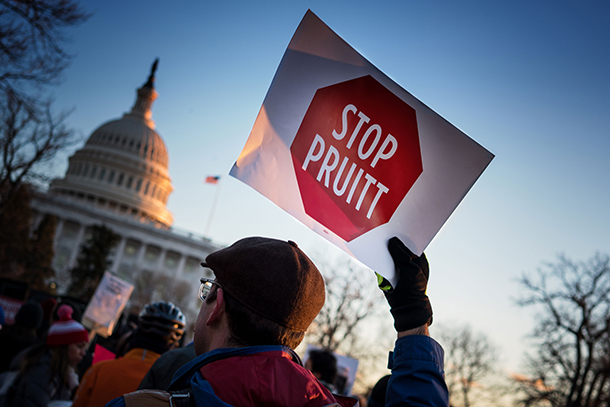
Voices on the left and right have been outspoken in their criticisms and concerns of the new EPA Administrator. (Photo: Laurie Shaull, Flickr CC BY-SA 2.0)
WALLACE: But, Sir, you’re giving me a regulatory answer, a political answer. You’re not giving me a health answer.
CURWOOD: Chris Wallace noted the Clean Power Plan’s predicted health benefits of averting hundreds of thousands of asthma attacks and lost time on the job. And the Fox anchor is not the only conservative voice calling out Scott Pruitt, as Mother Jones Washington reporter Rebecca Leber writes, and she joins us now. Welcome.
LEBER: Thanks for having me here.
CURWOOD: So, why are conservatives giving Administrator Pruitt such a hard time? Conservationists haven't been big fans, but why are the conservatives not so happy with him?
LEBER: Scott Pruitt offered this promise of rolling back the EPA to unprecedented levels - and that's actually a really challenging prospect for him - but conservatives have been hoping for someone like him at the helm of the EPA for years and have a very long wish list of what they would like to see. Their number one mission is to scale back the EPA's role in climate change and to do that, they would have to tackle the Endangerment finding, and that's the scientific and legal basis for all of the EPA's work on climate change and its regulations on vehicle emissions, on aircraft emissions, on power plants.
So, the Endangerment finding was essentially the EPA saying that climate change and carbon pollution and all greenhouse gases pose a threat to human health and the welfare of the US and the world. And conservatives recognize that that poses a big legal challenge for them in taking the EPA out of the equation on climate change.
Chris Wallace and Pruitt went head-to-head on Fox News.
Fox News' Chris Wallace grills EPA chief Scott Pruitt on gutting Obama clean air regulations https://t.co/FhIaOA7Cnb via @TheWeek
— @AdamsFlaFan (@AdamsFlaFan) April 4, 2017
CURWOOD: So, near as you can tell now, to what extent is Scott Pruitt resisting reviewing the Endangerment finding?
LEBER: That's a good question because I think there's some nuance that gets missed here. Pruitt has said he doesn't see any evidence for reviewing the Endangerment finding at this time and that that phrase "at this time" is key because he seems to be leaving the door open for potentially revisiting it in the future. That also could just be language that is meant to appease some of his critics on the right. It's hard to know at this point. So, at this moment he said he is not interested in reviewing that. Environmental lawyers have argued that's because he sees that a losing case already, even though waged a lawsuit over this as Attorney General.
CURWOOD: So, I don't get it. If he doesn't get the Endangerment finding tossed out then the EPA's going to be required to regulate carbon dioxide as a pollutant, one way or the other.
LEBER: They are, but there are plenty of other ways that the Trump administration can and has been going about weakening the EPA. One of them is through budget cuts. Another is by limiting staffing and just setting up obstacles for the daily work that the agency does.
CURWOOD: So, besides this whole question of endangerment and carbon dioxide as a pollutant, what else has conservatives so unhappy? The conservative media has been rather suspicious of him.
LEBER: So, the...You said conservative media, Breitbart, for example, has been one of the surprising critics recently of Pruitt. When he first was confirmed, a columnist there published really big praise of him and what he can do, comparing him to doing the Lord's work. Just a few weeks later, the same columnist was ripping Pruitt apart for not going far enough in saying that climate change isn't real, and that was in reaction to the Fox News interview, and saying that Pruitt might need to go if he doesn't tackle the Endangerment finding.
CURWOOD: Now, what about the investigation about Mr. Pruitt's ties to the fossil fuel industry that the California Attorney General Xavier Becerra is conducting?
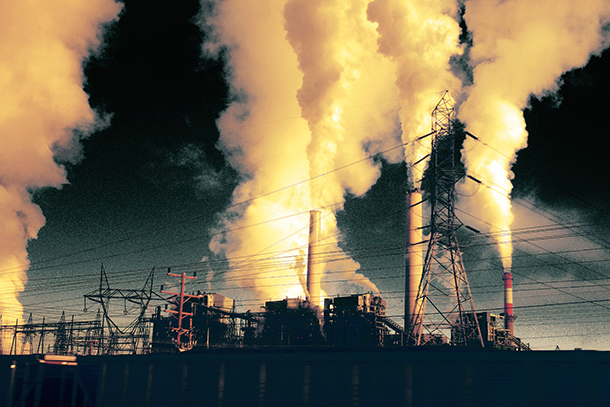
In 2009 after exhaustive review, the EPA made the endangerment finding which classifies greenhouse gases as pollutants that endanger public health. (Photo: Andrew Hart, Flickr CC BY-SA 2.0)
LEBER: So, this dates back to well before his confirmation where environmentalists and Democrats have long sought after his emails and communications with the fossil fuel industry. In some cases, as the New York Times reported years ago, Pruitt copied language from lobbyists in the oil industry. So, Pruitt has been at the center of a lot of FOIA requests. The one that was extremely high-profile was when he was getting confirmed. Democrats pushed to delay his confirmation in order to go through trove of new emails that an Oklahoma judge had just turned over because Pruitt's office had dragged its feet on delivering those emails, and at the rate it's going we could expect more to come out. People are digging through his emails and records, myself included, to discern what that relationship is.
CURWOOD: Now, there's a record of EPA leaders being fired or resigning without completing their full term when the party changes. What do people tell you what lies ahead for Mr. Pruitt with all these conflicts and investigations that are swirling around his very short time so far in office when they come to a head?

Rebecca Leber is a Reporter for Mother Jones. (Photo: Rebecca Leber)
LEBER: There's been a lot of parallels made, more by the left, to Ann Gorsuch, who didn't make it very long as EPA administrator and resigned due to mismanagement over Superfunds. And at the moment, Pruitt is alienating people on the left, right, even the middle, on all these issues, and he… Faced with steep budget cuts, if those do come to pass, what the Trump Administraion has proposed could make his job impossible where he says he wants to improve clean water and air and cleaning up Superfunds at the same time the EPA faces its biggest cut to the agency it's ever seen.
CURWOOD: Rebecca Leber is a reporter for Mother Jones. Rebecca, thanks so much for taking the time with us today.
LEBER: Thanks so much for having me here.
Related links:
- Mother Jones: Rebecca Leber’s article “Donald Trump’s First 100 Days in Office Have Been a Disaster. Scott Pruitt’s Have Been Even Worse.”
- Huffington Post: The Chris Wallace and Scott Pruitt “Fox News Sunday” interview
- CNBC: “Scott Pruitt’s latest climate change denial sparks backlash from scientists, environmentalists”
- California AG Xavier Becerra FOIA Filing regarding Scott Pruitt
Beyond The Headlines
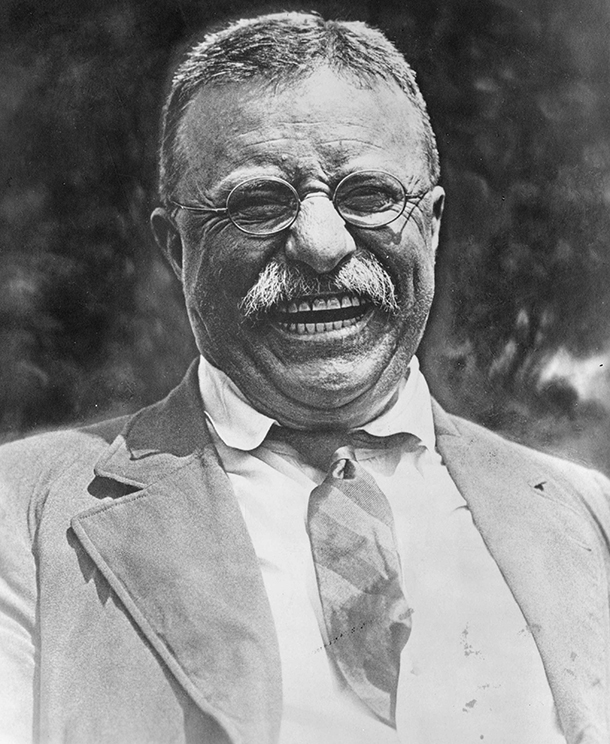
In 1907, Republican President Theodore Roosevelt addressed the school children of the United States in an advance apology for the destruction of nature his generation was undertaking. (Photo: Wikimedia Commons, public domain)
CURWOOD: Let’s join Peter Dykstra, of Environmental Health News -- That’s ehn dot org and DailyClimate dot org -- now to catch up on the world beyond the headlines. Peter’s been off for a while but is back now on the line from Atlanta, Georgia – how are you Peter, how are you doing?
DYKSTRA: I’m getting better, Steve, I’m on the mend.
CURWOOD: Well hang in there, what do you have for us this week?
DYKSTRA: Well, you’ve just been talking about Scott Pruitt and he’s unsurprisingly showing the same contempt for environmental regulation in his new role as EPA boss as he did during six years as Oklahoma Attorney General. One 25 year EPA employee, Mike Cox, fired off a scorching resignation letter citing “indefensible budget cuts,” among other things.
CURWOOD: Yeah but it’s not just budget cuts that are prompting anger, lawsuits, and protests involving Mr. Pruitt.
DYKSTRA: Oh, absolutely not. One of the most conspicuous flashpoints is that Administrator Pruitt ignored his own agency’s scientific advice in lifting an Obama-era ban on chlorpyrifos, also known as Dursban. It’s one of the most widely used agricultural pesticides, used on everything from citrus, wheat, corn, apples, strawberries. It’s also widely used on golf courses. Chlorpyrifos is considered a neurotoxin and believed to cause low IQ and low birth weight in newborns. EPA has placed it off-limits for residential use since the year 2000.
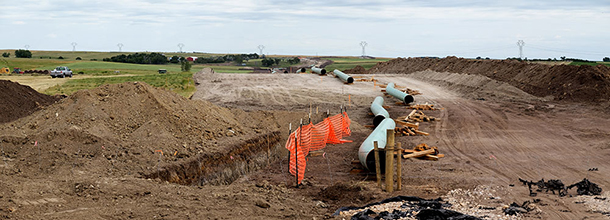
Although construction of the Dakota Access Pipeline began during Obama’s Presidency – this photo is from July of 2016 -- and has been allowed to continue under President Trump, two Democratic senators have sent a letter to the Army Corps of Engineers arguing that building began without the proper permission. (Photo: Lars Plougmann, Flickr CC BY-SA 2.0)
CURWOOD: So, this is at least controversial, at worst really nasty stuff. So, you see this as a sign of how Mr. Pruitt’s EPA will address other issues?
DYKSTRA: Yeah, almost definitely. One has to assume that it is. It’s consistent with what Pruitt has said and done throughout his career.
CURWOOD: Okay, what do you have next for us?
DYKSTRA: In what may be one of the final legal efforts to stop the Dakota Access pipeline, two U.S. Senators, Democrats Maria Cantwell of Washington State and Tom Carper of Delaware, sent a letter to the Army Corps of Engineers contending that Energy Transfer Partners and its contractors may have jumped the gun, building their pipeline under Lake Oahe, before they had permission to do so.
CURWOOD: And of course, that lake is the drinking water source for the Standing Rock Sioux and other tribes.
DYKSTRA: And of course that threat, as well as the disruption of sacred tribal sites are among the main reasons for months of protests and occasionally violent responses. Meanwhile, the Trump Administration has issued an Executive Order granting an easement. The Dakota Access pipeline does not have to obey certain environmental regs or impact assessments.
CURWOOD: And finally, hey, Peter, take a look back at environmental history for us now. What do you have for us this week?
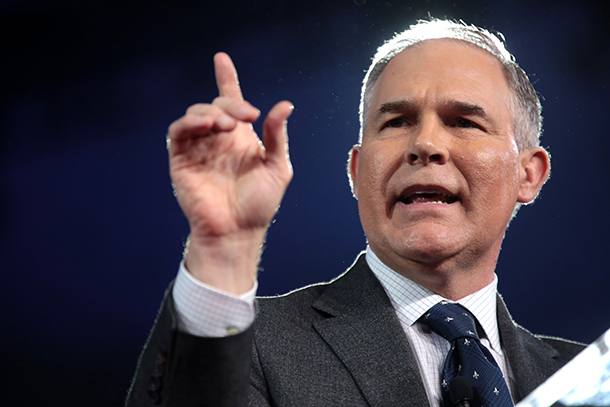
EPA administrator Scott Pruitt is facing a slew of lawsuits and protests against his agency, and also losing some staff members who have resigned. (Photo: Gage Skidmore, Flickr CC BY-SA 2.0)
DYKSTRA: Well, I’ve got yet another reminder that not all Americans started thinking about the environment in recent years, because 110 years ago this week, in what he called his “Message to the School Children of the United States,” President Theodore Roosevelt – That’s Republican President Theodore Roosevelt – said this:
"We of an older generation can get along with what we have, though with growing hardship; but in your full manhood and womanhood you will want what nature once so bountifully supplied and man so thoughtlessly destroyed; and because of that want you will reproach us, not for what we have used, but for what we have wasted.”
CURWOOD: Boy, it’s a shame we don’t have recordings of statements like that from 1907, huh?
DYKSTRA: Oh, so you’re saying you don’t like the way I read it?
CURWOOD: No, no, no, I’m just saying it would be great to have the wisdom of Teddy Roosevelt on tape.
DYKSTRA: Yeah, in many ways he was a century or more ahead of his time.
CURWOOD: Well, Peter, we’re glad you’re back and hope you’re headed for a full recovery soon.
DYKSTRA: All right, Steve, thanks a lot and we’ll talk to you soon.
CURWOOD: Peter Dykstra is with Environmental Health News. That’s EHN.org and DailyClimate.org. And there’s more on these stories at our website LOE.org.
Related links:
- Washington Post: “EPA staffer leaves with a bang, blasting agency policies under Trump”
- The Guardian: “Environmentalists sue EPA for reversing Obama-era move to ban pesticide”
- Indian Country Today: “ Senators allege DAPL builder didn’t have permit to build under Lake Oahe”
- Climateconservative.org: “Theodore Roosevelt’s ‘A Message to the School Children of the United States”
[MUSIC: New Black Eagle Jazz Band, “Only a Look” on Higher Ground, traditional American, CD Baby]
CURWOOD: Coming up...doctors organize to warn the public about the health risks of climate disruption. Stay tuned to Living on Earth.
ANNOUNCER: Support for Living on Earth comes from the Gordon and Betty Moore Foundation, and from a friend of Sailors for the Sea, working with boaters to restore ocean health.
[CUTAWAY MUSIC: New Black Eagle Jazz Band, “Come Sunday,” on Higher Ground, Duke Ellington, CD Baby]
Roundup® Maker Sued Over Cancer Risks

California’s Office of Environmental Health Hazard Assessment recently determined that glyphosate—a chemical in Roundup—will be added to the list of chemicals to be labeled as being suspected to cause cancer. Monsanto says that Roundup is perfectly safe. (Photo: Mike Mozart, Flickr CC BY 2.0)
CURWOOD: It’s Living on Earth, I’m Steve Curwood. A judge in California recently ruled that the state can require Monsanto to label its popular weed-killer Roundup as a possible carcinogen, even though the firm contends that the key ingredient, glyphosate “has a long history of safe use”.
The move comes as the giant seed and pesticide conglomerate faces dozens of lawsuits from plaintiffs who allege the company misled the public about the risks of Roundup and thus compromised the health of workers. The plaintiffs claim that exposure to Roundup® caused them to develop non-Hodgkin’s lymphoma.
Recently unsealed court documents suggest that studies attributed to academics were actually ghostwritten by Monsanto employees, and that U.S. regulators based their determination that glyphosate is not a cause of cancer on those studies.
Among the lawyers suing Monsanto is environmental legal activist, Robert Kennedy, Jr., who incidentally suffers from spasmodic dysphonia that affects his voice. Welcome to Living on Earth, Mr. Kennedy.
KENNEDY: Thanks for having me.
CURWOOD: So, who are the people who are bringing this lawsuit against Monsanto? How were they interacting with Roundup®?
KENNEDY: Among the law firms that are part of our coalition, there are about 3,000 clients who have already signed up. And these are people who are farmers. Many of them are gardeners, are people who had backyard gardens and either have been directly impacted -- In other words, they have of non-Hodgkin's lymphoma -- or they have a relative who has died from non-Hodgkin's lymphoma.
CURWOOD: Now, in this particular case, Monsanto and the EPA both say that the main ingredient in Roundup®, glyphosate, is safe, but then we had the World Health Organization calling it a probable carcinogen to humans. Bobby, from what you can tell, what is there in the way of a scientific consensus on this issue of glyphosate and human health.

Environmental lawyer Robert F. Kennedy Jr. is part of the litigation team representing the plaintiffs. (Photo: Daniel Schwen, Wikimedia Commons CC BY-SA 4.0)
KENNEDY: There's two issues. One is that glyphosate alone is less toxic, we know, and glyphosate in the formulation of Roundup®. There are surfactants and adjuvants in Roundup® and particularly a class of surficants known as tallowamines. That makes glyphosate far more toxic than it is alone, in fact, there's implications that it might be 10,000 times as toxic when combined with the tallowamines. The reason that the tallowamines make it more toxic is that they allow the glyphosate to penetrate human skin on contact in very, very high concentrations.
We also have studies by the premier, gold standard cancer research organization on Earth, which is the International Association for Cancer Research or IARC, which is an organization that is funded by 16 industrialized countries, and most nations, most European countries recognize, and countries all over the world, that nobody really had the resources to measure all of these chemicals that we're now swimming around in for carcinogenicity, and we needed to have one centrally funded and adequately, abundantly funded organization and use the highest scientific standards and employ the best scientists on Earth, and that organization has determined that glyphosate is a probable carcinogen.
CURWOOD: Now, Roundup® is used on more than 100 crops, and is registered in the 130 countries, but EPA has determined that there is little risk for most Americans in the quantities they say they are usually exposed to. How accurate is that?
KENNEDY: It's not accurate, and unfortunately what the documents that have been recently released by Judge Chhabria show is that there was a history of collusion between the EPA pesticide division which was helping Monsanto cover up the dangers of glyphosate and Roundup® as well. The head of the pesticide branch was a guy named Jess Rowland, who had this very disturbing relationship with Monsanto in which there are emails that show him going to bat for Monsanto. At one point, he tells...
A conversation is described in the email in which Jess Rowland pledges to derail an investigation of glyphosate and Roundup by the HHS. We have permission to depose Jess Rowland. We've also deposed David Hayden, who is the Monsanto executive who was coordinating the cover up with the EPA.

Judge Vince Chhabria, of the U.S. District Court for the Northern District of California, unsealed documents that allege collusion between EPA personnel and Monsanto. (Photo: Mccready, Flickr CC BY 2.0)
In answer to your question about whether EPA science is trustworthy, it's not. And in fact, EPA had a long history of … That particular division is kind of a poster child for what we call “agency capture phenomenon,” where the regulatory agency becomes captured by the industry that it's supposed to regulate.
CURWOOD: And what about then our regulators? What sanctions if any are you seeking against the EPA for approving Roundup®?
KENNEDY: Well, the EPA should be sanctioned for this. In particular, what's very strange about EPA is that, instead of coming clean, what EPA has been trying to do is to block us from deposing Jess Rowland and to cover up the documents in its possession. It is particularly disturbing since recently there's been a number of other developments since the Trump administration came into office.
Scott Pruitt, formerly the Attorney General of Oklahoma, is one of the biggest recipients of funding for Monsanto. He is a creature…His political career has been a creature of the agricultural chemical industry and factory farming industries. He really was hand-selected by those industries to become Attorney General of Oklahoma in order to derail a series of lawsuits that his predecessor had brought against Big Ag. And he's recently expressed an unwillingness to look further into glyphosate.
In addition to that, a number of independent testers have found that America's cereals, breakfast cereals fed to children are loaded with glyphosate, and the USDA in Texas had made a settlement of the lawsuit and the settlement required USDA to look into, to conduct an investigation of glyphosate in cereals, and the USDA has just announced that it is going to drop that investigation. That's disturbing because we're all getting these big exposures to glyphosate that may be damaging to our kids who are particularly vulnerable, and we have a government now that is…seems anxious to collude with Monsanto in this long collaboration and seal the dangers of glyphosate to human health.

Many of the plaintiffs are farmers and people with backyard gardens who used Roundup® to control the weeds around their crops, or whose now-deceased family members did so. Roundup® is used on more than 100 crops and registered in 130 countries. (Photo: Brian Robert Marshall, Wikimedia Commons CC BY-SA 2.0)
CURWOOD: Robert F. Kennedy Jr is an environmental lawyer and activist. He joined us from Washington DC. Bobby, thanks so much for taking the time today.
KENNEDY: Thanks so much for having me.
CURWOOD: We asked Monsanto for their response to these allegations. Charla Marie Lord, Monsanto’s Senior Media Communications Manager, sent an email which is posted in full at our website, LOE.org.
It reads in part:
“First, the allegations of 'ghostwriting' that you mention have been extensively addressed and refuted.
The email concludes “no regulatory body in the world considers glyphosate to be a carcinogen.
Plucking a single email out of 10 million pages doesn’t change this fact."
The EPA declined to comment on the emails of Jess Rowland that have been entered into evidence.
Full Monsanto Statement, provided by Charla Lord of Monsanto's Corporate Engagement office (discover.monsanto.com):
"These allegations have been extensively addressed and refuted. The Monsanto scientist who wrote the email in question has testified under oath regarding the paper, and New York State Medical College has conducted its own investigation and dismissed the claims. We have been in the record in many outlets refuting these false claims.
"The conclusion of paper in question, “Safety Evaluation and Risk Assessment of the Herbicide Roundup and Its Active Ingredient, Glyphosate, for Humans,” by Gary M. Williams, Robert Kroes and Ian C. Munro in Regulatory Toxicology & Pharmacology (2000), is consistent with the findings of regulatory authorities around the world, a branch of the World Health Organization that analyses pesticide residues, and one of the largest databases ever compiled on an agricultural product. In fact, the same week the plaintiffs’ attorneys released these documents, the European Chemicals Agency concluded yet another review on glyphosate and concluded that it is not a carcinogen.
"To be clear: No regulatory body in the world considers glyphosate to be a carcinogen. The allegation that glyphosate can cause cancer in humans is inconsistent with decades of comprehensive safety reviews by the leading regulatory authorities around the world. The plaintiffs have submitted isolated documents that are taken out of context. Plucking a single email out of 10 million pages doesn’t change this fact."
Related links:
- Bloomberg: “Monsanto Cancer Suits Turn to EPA Deputy’s ‘Suspicious’ Role”
- NYTimes: “Monsanto Weed Killer Roundup® Faces New Doubts on Safety in Unsealed Documents”
- The Mercury News: “Monsanto Weed Killer Caused Cancer, Californians allege in new lawsuit”
- OEHHA: “Glyphosate to be Listed under Proposition 65 as Known to the State to Cause Cancer”
- Monsanto’s Response to The International Agency for Research on Cancer’s study on Glyphosate
- Environmental Working Group statement on Roundup® and pregnancy
[MUSIC: Denver Symphony, “The Sorcerer’s Apprentice” on Classics At the Movies, Paul Dukas, Intersound Records]
Science Note: Why Lyme Disease Thrives Up North
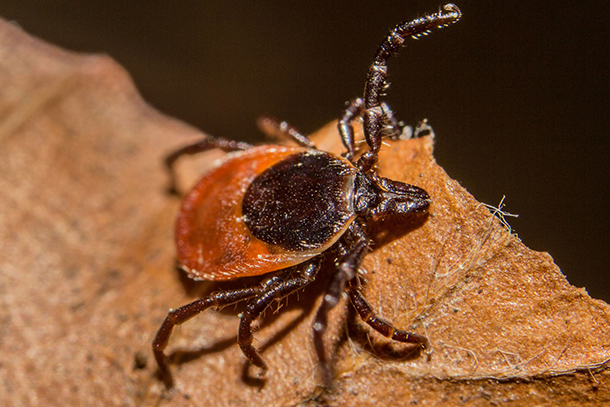
The blacklegged tick, also known as the deer tick, is the only kind of tick that carries Lyme disease (Photo: Lennart Tange, Flickr CC BY 2.0)
CURWOOD: And now, this note on emerging science from Don Lyman.
[SCIENCE NOTE THEME]
LYMAN: Lyme disease, caused by the bacterium Borrelia burgdorferi, is transmitted by ticks that bite infected animals. An infected tick can then transfer the disease to you or me, if it should happen to bite us. The typical symptoms of Lyme disease are fever, headache, fatigue, and often there’s a telltale rash. If not treated promptly, it can damage the heart, nervous system, and joints.
About 300,000 people are infected with Lyme disease every year, but it is far more common in the North than in the South. Approximately 95 percent of all reported cases occur in 14 states in the Northeast, Mid-Atlantic, and upper Midwest. Now scientists from the U.S. Geological Survey think they know why. In a recently published study, the researchers said that black-legged ticks, which transmit the disease, die of dehydration when exposed to high temperatures and low humidity.
An earlier study found that black-legged ticks in the south tend to stay hidden under a layer of fallen leaves, where, scientists hypothesize, they are able to retain moisture but are less likely to come into contact with people. And researchers found that ticks in the North often climb up plant stems, where they may more easily latch on to people who brush against them.
So, when you take a walk in the woods in the North, beware! You can be walking right through tick habitat, while in the South you’ll be walking on top of it.
That’s this week’s note on emerging science. I’m Don Lyman.
[SCIENCE NOTE THEME]
Related links:
- The USGS Study on the geographical distribution of Lyme disease
- CDC information on Lyme disease
- Tick Counter Tool
- American Lyme Disease Foundation website
Climate Change and Your Health

Above, young people in Moscow wear masks during the deadly 2010 heat wave and forest fires in Russia. Air quality declines as a result of high temperatures and wildfires, threatening the health of everyone -- especially children, the elderly, and people with heart conditions and asthma. (Photo: Artem Svetlov, Wikimedia Commons CC BY 2.0)
CURWOOD: Climate change threatens everything from fires, floods, water supplies and property values, but not enough people are aware of the risks it poses to personal health. So says a new organization, representing some 400,000 doctors, called the Medical Society Consortium on Climate and Health.
Mona Sarfaty, the Director of the consortium, explained its purpose.
SARFATI: So, the consortium is formed because physicians are increasingly concerned about the impact that climate change is having on the health of the patients that they're taking care of. There has been a realization by physicians around the country that certain ailments are climate related and that they're becoming more frequent.
CURWOOD: So, this is going beyond insects and other vectors like rodents moving north because it's a little bit warmer. There are even more health related concerns, I gather, now related to climate change.
SARFATI: There is a very long list of problems associated with climate change that is starting to affect people all over the country, although certain areas are certainly more vulnerable than others. There are problems that are associated with extreme weather and extreme temperatures, especially heat waves, fires, floods, deteriorating air quality, but also water quality and damage to crops and even damage to the nutrition that comes with eating those crops.
CURWOOD: So, what kind of diseases are we seeing increase as a result climate change?
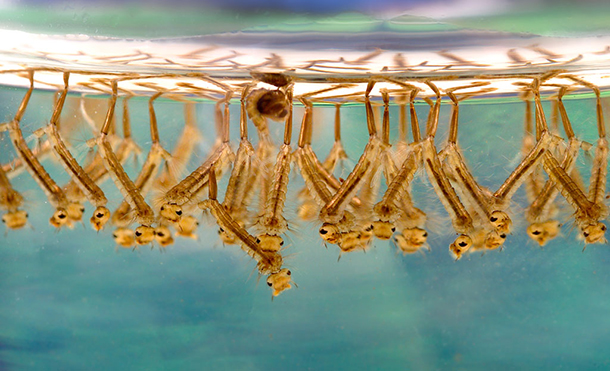
Larvae of the Culex mosquito, which carries West Nile Virus. The rise in the disease in North America in recent years has been linked to climate change. (Photo: James Gathany / CDC, Wikimedia Commons CC BY 2.5)
SARFATI: Lyme disease is one glaring example. A physician from Rhode Island who is one of our leaders talked about his practice and how they used to see two to three cases a month during the warmer season and now is seeing 40 to 50 cases in a season. And of course, then there is West Nile virus which is resident, you know, where there have been outbreaks. We've got the mosquito that carries Zika potentially spreading north. It's already resident in many states.
CURWOOD: Now, as I understand it, your mission statement is based on educating the public and policymakers on the health related impacts of climate disruption. How do you go about that mission?
SARFATI: I'm so glad you asked about that. We had a press conference, and we had physicians from many different specialties talk about what they personally were seeing in their practice, and we issued a report called, "Medical Alert: Climate Change Is Harming Our Health". It's on our website. We've already now delivered it to the public, and now we're delivering it to policymakers. So, we're taking it to members of Congress and to the governors, the National Governors Association, and to the U.S. Conference of Mayors and to policymakers at the state level. We want to open a conversation with everybody about the risks of climate change, the threats of climate change to the health of all Americans.
CURWOOD: Now, your report says that, although almost everybody is, who among us is the most vulnerable and how so?
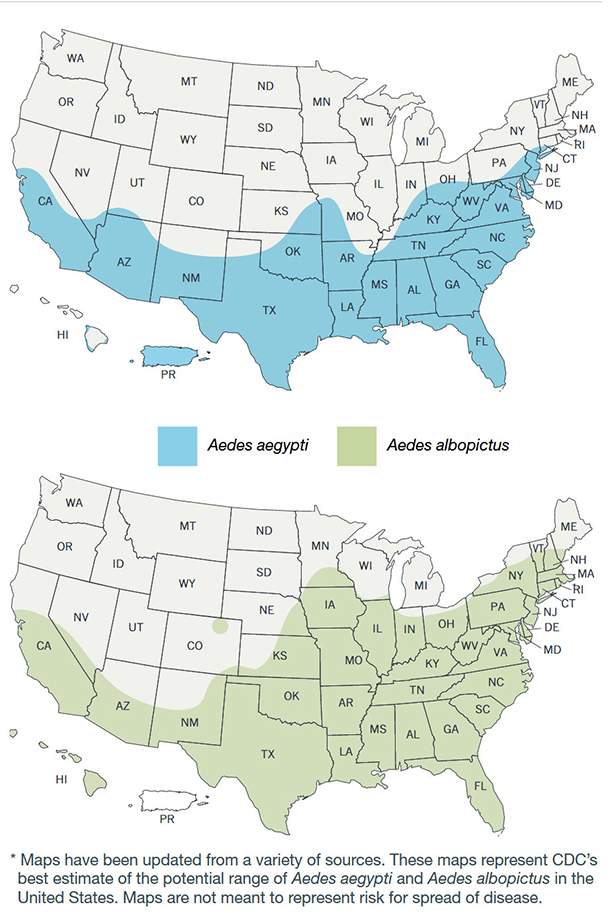
Estimated current range of Aedes mosquitos (Aedes aegypti in blue, Aedes albopictus in green), which have the ability to carry Zika and other viruses. (Photo: U.S. Department of Health and Human Services Center for Disease Control)
SARFATI: So, some people are vulnerable by virtue of their age, and with regard to heat, you've got the very young and the very old. An example of that is that a third of the visits to emergency rooms for heat related illnesses are now school kids playing sports. And then of course people who work outside are more vulnerable to heat, and a lot of people work outside. And when it's hot, air quality worsens because more ozone forms, and then you've got anybody who has a respiratory or cardiac condition who is potentially vulnerable because ozone is very irritating to the lungs. Then some people are vulnerable by virtue of where they live. If you live in an area which is prone to flooding or along the coast, or where there are forests that are dry and are vulnerable to wildfires. And then people who are lower income are vulnerable because when these extreme events happen, they may find it more difficult to get out of harm's way.
CURWOOD: And you mentioned that obstetricians and gynecologists are part of your coalition. What are the particular risks to women from climate disruption?
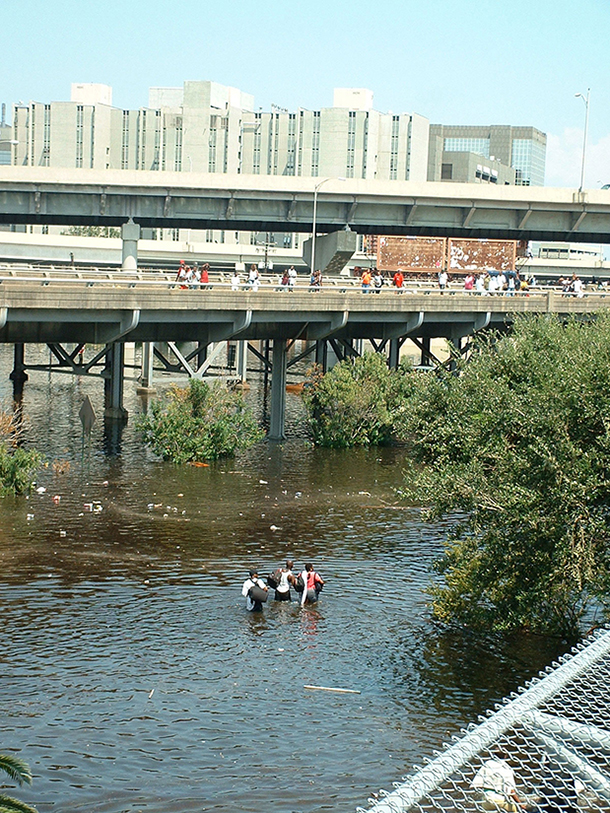
Residents of New Orleans seeking refuge from the flood waters following Hurricane Katrina in 2005. Climate change is expected to have greater impacts on low-income and disadvantaged communities who are already vulnerable to flooding and other issues. (Photo: U.S. Federal Emergency Management Agency)
SARFATI: Women are somewhat more prone to mental health impacts from extreme weather events and the social disruption that is caused by extreme events. But it's also true that pregnancy makes women more vulnerable, and the new president of the American College of Obstetrics and Gynecology spoke about low birth weight and how that can be caused by heat or by poor air quality. So, low birth weight means premature delivery, and premature delivery and saving those babies in the hospital is one of the most expensive pieces of medical care. So, there's a direct connection between these deteriorations that we're seeing in the climate and how that affects pregnant women and then the treatment in hospital in the way that keeps health care cost elevated.
CURWOOD: So, we've seen that since the beginning of the present administration a number of public statements and policies that show that climate change is not a priority at the federal level. How do you think this current political climate is going to affect your approach to educating policymakers and the public?
SARFATI: Well, you know, we have members that have been talking to Congress for quite a while, so there are well established relationships with policymakers. And now we have members of those societies who come from all over the country. At our launch we had somebody from Montana. We have a physician from North Carolina who’s quite outspoken. We have somebody from Louisiana who lived through the recent torrential flooding in Baton Rouge. So, we have physicians who can speak to policymakers from all around the country.
CURWOOD: How do you think public policy should be changed now in response to the emerging threats from climate change? What should public health folks be thinking about?
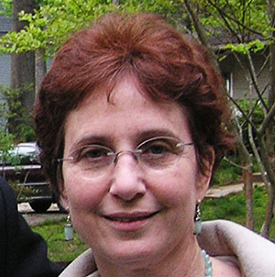
Dr. Mona Sarfaty, Director of the Medical Society Consortium on Climate and Health and Director of the Program for Climate and Health at George Mason University’s Center for Climate Change Communication. (Photo: Center for Climate Change Communication, George Mason University)
SARFATI: One really important piece of what the consortium is doing is to try to share information with other clinicians, so that they understand what kind of risk their patients are subject to, and they can prepare themselves and their patients despite whatever events may happen. Once people understand that they're at risk, then they can seek to become aware of exactly what those risks are, depending upon where they live or their underlying health condition.
And there's a lot of information out there. We do have heat alerts. People can stay tuned to the heat alerts. We have air quality indices which are carried in the newspaper and various other places. They can understand what the health risks are in their own families, whether they have relatives who have chronic lung or heart disease or kids with asthma and seek to do what's necessary to protect them. There's quite a bit that people can do, but it all starts with being aware that the risks are there.
CURWOOD: Mona Sarfati is Director of the Medical Society Consortium for Climate and Health. Dr. Sarfati, thanks so much for taking the time with us today.
SARFATI: Well, thank you so much. Really appreciate it.
Related links:
- Webinar from The Medical Society Consortium on Climate & Health Launch
- “Medical Alert! Climate Change Is Harming Our Health”
- The Guardian: Article by Mona Sarfaty, “Climate change is thawing deadly diseases. Maybe now we’ll address it?”
[MUSIC: The Gipsy Kings, “Love & Liberte” on The Best Of the Gipsy Kings]
CURWOOD: Coming up...the Great Lakes contain a fifth of the world’s surface fresh water, but they are under threat. That’s just ahead here on Living on Earth. Stay tuned.
ANNOUNCER: Funding for Living on Earth comes from you our listeners, and United Technologies - combining passion for science with engineering to create solutions designed for sustainability in the aerospace, food refrigeration and building industries. UTC companies such as Otis, Carrier, Pratt & Whitney and UTC Aerospace Systems are helping to move the world forward.
This is PRI, Public Radio International.
[CUTAWAY MUSIC: The Gipsy Kings, “Love & Liberte” on The Best Of the Gipsy Kings, Nonesuch Records]
Death and Life of the Great Lakes

Quagga mussels and Deepwater Sculpin, collected by NOAA during a benthic trawl of Lake Michigan. Population numbers of the sculpin and many other fish species in the Great Lakes have dropped as quagga mussels have skyrocketed. (Photo: NOAA)
CURWOOD: It’s Living on Earth. I’m Steve Curwood.
On April 24, 1959, this was the Canadian Broadcasting Corporation…
[MUSIC]
RADIO ANNOUNCER: 270 years ago, fur traders and missionaries hacked their way through the forest of New France. They were looking for an easy way into the Great Lakes and a way to bring lake ships around the rapids to the sea. They completed a 2,000 yard ditch. Then one August night, the Iroquois massacred the building party.
[SHIPS HOOTER]
But they had started. Yesterday, the St. Lawrence Seaway was opened.
CURWOOD: The opening of the link from the Great Lakes to the sea along the US-Canadian border was the fulfillment of a dream and a vision for the heartland of the continent that environmental journalist Dan Egan details in his new book, “The Death and Life of the Great Lakes”.
EGAN: The whole idea behind the St. Lawrence Seaway was to essentially carve an American Mediterranean out of the middle of the continent, by basically blasting a shipping channel between the Great Lakes and the Atlantic Ocean. The Great Lakes collectively span 94,000 square miles, which is basically the size of the UK, but in a lot of ways they were as isolated as a pond in the middle of the woods, because there was no way anything from the ocean or from the eastern seaboard could get up into the lakes because of Niagara Falls and from Lake Ontario, the roaring, tumbling St Lawrence River. And on the western side, there was what they call a subcontinental divide, which basically was a ridgeline that separated the Great Lakes waters from those of the Mississippi River basin.
CURWOOD: Really, Dan, one of the things that's fascinating about your book is you say that when the St Lawrence Seaway was built it was already obsolete practically on the day that it opened. Why didn't it become the trade highway that its builders envisioned, do you think?
EGAN: A couple of reasons. One, they built it on the cheap. They built it to match some existing locks that bypass Niagara Falls - It's known as the Welland Canal - and those locks were built in the 1930s, so there was no sense in building along the St. Lawrence River a whole new set of locks that were much larger because the boats would have hit a bottleneck at the Welland Canal, and they weren't about to rebuild the Welland Canal because it was going to double the cost of the project. So, they built it on the cheap and the size of the locks and the channels really reflected the size of the world's fleet in the 1930s, not in the late 1950s or early 1960s.
And there was another reason too, and that's ice. You know, you can't have a world class shipping corridor that shuts down for three months of the year; otherwise, you know, the car plants aren't going to get their clutches or whatever they need. In this world of just-in-time delivery, you need fast, dependable, predicatable, perennial deliveries, and you can't do that with a navigation route that is choked by ice.
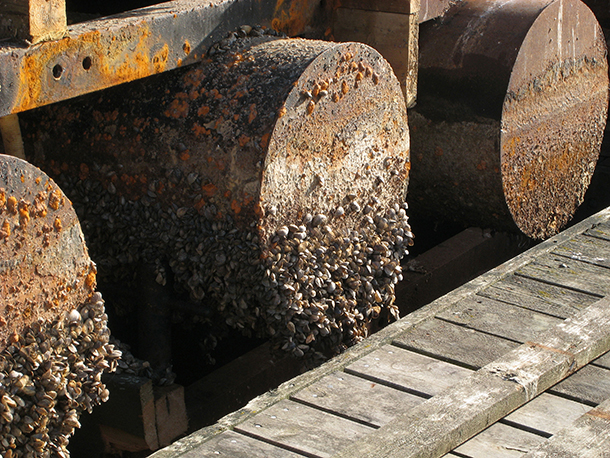
Docks pulled from Port Credit Marina on the Canadian side of Lake Ontario that are covered in zebra mussels. (Photo: Gene Wilburn, Flickr CC BY-NC-ND 2.0)
So, what we're left here is really kind of a boutique shipping industry. The boats, while huge on a human scale, are not are very big on the grand scale of today's modern fleet. Maybe five percent of the world's cargo carrying capacity can fit in the locks. And so what happened was, the seaway opened in 1959, and the container revolution took off almost simultaneously, and that demanded bigger and bigger boats so the seaway got squeezed aside. So, what we have today is a system where a limited number of ships - On average it's been fewer than two per day during the nine month shipping season – come in up the St. Lawrence Seaway from overseas and deliver their cargo to Great Lakes ports. And their cargo is not high-value goods like Nikes and Sonys and Toyotas. It's primarily bulk goods, largely steel, which we know how to build steel here, and outbound is grain. They take grain off the plains and move it to the western Great Lakes ports, put it on boats and take it all over the world.
CURWOOD: But, even if the link the Seaway provided to the rest of the world was not the huge commercial success hoped for, it did bring in plenty of life, though it was the wrong kind. Invasive species from alewives to zebra mussels hitched rides in ballast tanks of ocean freighters. And as the agricultural center of North America flourished, with increasing pesticide and nutrient run-off from corn and wheat fields into the Great Lakes, author Dan Egan says the consequences of the biological pollution became clear.
EGAN: It's really a number of organisms working in concert. I'll give you an idea of how dangerous this biological pollution can be. Zebra and Quagga mussels, tiny little mollusks that invaded the Great Lakes from the Caspian Sea basin, now blanket the bottom of the Great Lakes. If I were to walk from Milwaukee the 80 or 90 miles across the lake to Muskegon, Michigan, I could do the whole trip basically on a bed of Quagga mussels.
So, why is that dangerous? If you look at what happened to Lake Erie in 2014, in late August, I believe, 500,000 people lost their drinking water, and they lost their drinking water because there was an outbreak of a toxic algae called Microcystis which produces a toxin called Microcystin. That's naturally occurring in the Great Lakes, but these mussels basically eat everything but that algae, so that algae has no competition. So, when the conditions set up in western Lake Erie, for example, there's a lot of phosphorus going into the lake because that's big corn country on the western end of Lake Erie. So you get the temperatures and the fertilizer and the water conditions for an algae bloom, and, where 50 years ago it might have been a whole array of different types of organisms, now it's pretty much a Microcystis show. So, it's a pollutant, you know, just as toxic and dangerous and problematic as anything that can come out of an industrial pipe or smokestack.
CURWOOD: So, what's the solution? How do you get rid of these invasive species, these mussels that cause so much trouble?
EGAN: Well, that's the problem, you don't. I mean and that's the difference between this traditional sense of pollution where you can cap a smokestack or plug a pipe, but this doesn't decay or disperse, this biological pollution. It breeds.
It doesn't mean that Lake Erie's water is going to be poisonous from here on out every late summer. There are other things we can do. Specifically, we can reduce the amount of phosphorous going into the lake, but the mussels are here and we're really going to just have to learn to live with them.
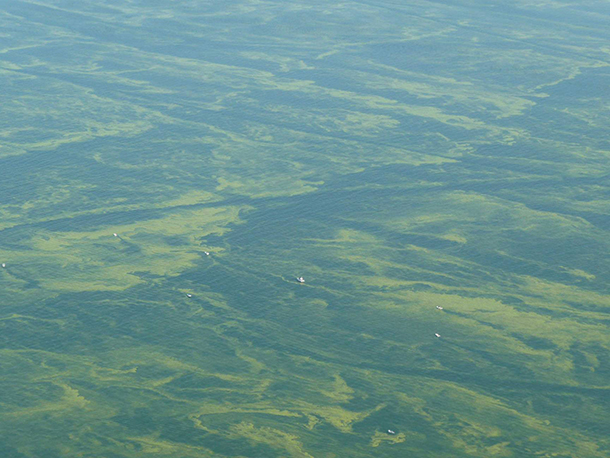
An algae bloom in Lake Erie in 2009. Phosphorus runoff from agriculture along the lake can lead to explosive algae growth in late summer. (Photo: Michiganseagrant, Flickr CC BY 2.0)
CURWOOD: Now there's another significant water passageway that you focus on, and that's the Chicago canal, which was originally built to bridge the divide between the Great Lakes and the Mississippi. Why was this canal constructed, and why is it a problem? Why is the Army Corps of Engineers now looking at ways to block it up?
EGAN: Well, like the St. Lawrence Seaway, the Chicago Sanitary and Ship Canal was a good idea at the time. And so it opened in 1900, and it was built because the booming city of Chicago was basically dumping its raw sewage into the Chicago River. The river flowed into the Lake Michigan, and that's where the city's drinking water intakes were. So, Chicagoans were basically drinking their own filth, and the crude but somewhat elegant solution was to reverse the river, and suddenly we have a river flowing out of Lake Michigan instead of into Lake Michigan.
And it solved Chicago's drinking water problems, but the consequences of doing this are now coming into focus for a number of reasons, not the least of which are these super carp known as Asian carp that have infested the Mississippi River basin. They're kind of like mini baleen whales, but they're not that mini. They can grow up to about 100 pounds and eat up to 20 percent of their weight in plankton today and are moving their way up the Chicago Sanitary and Ship Canal toward Lake Michigan and the Great Lakes.
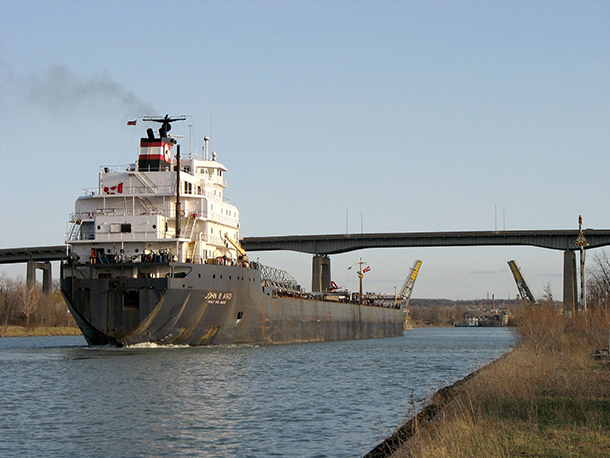
The John B. Aird passes through the Welland Canal, the passage along the St. Lawrence Seaway connecting the Great Lakes to the Atlantic Ocean. (Photo: Wikimedia Commons CC BY 2.0)
CURWOOD: So, overall, invasive species have cost folks around the Great Lakes a lot. We're talking hundreds of millions of dollars, maybe billions of dollars, and as you point out, the Midwest is still doing a lot more trade via railways from east coast harbors than from ships in their own ports. So, I'm scratching my head. Why do these lake economies continue to keep their harbors open to the risk of foreign vessels?
EGAN: Well, that's a good question, and I want to be clear that the seaway and Great Lakes shipping, it is an important navigation corridor, but the vast majority of goods moved along the seaway and on the Great Lakes are moved by local boats, but not by overseas freighters, and these aren't the boats that are bringing in invasive species. The overseas industry is a tiny component of the big picture. It's maybe five percent of the cargo moved by tonnage, and it's the equivalent of roughly two boats a day coming into the seaway during the nine month shipping season. So, it's not a big industry, but it is an important one to the people who own the boats and to the port operators, and they've been very active in making sure that it continues to operate as it has historically.
I should note they've taken steps to address this ballast issue, some big important and effective steps, to require boats coming into the Lakes to flush their ballast tanks mid-ocean with salt water, the idea being that it will expel or kill any freshwater hitchhikers, but the science shows that this salt water flush, though it goes a long way to reducing the threaten, it by no means eliminates it.
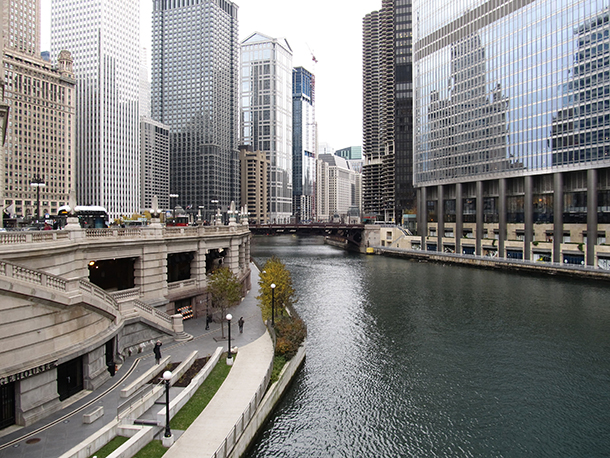
Before 1900, the Chicago River flowed into Lake Michigan, but with the construction of the Chicago Sanitary and Ship Canal, its course was reversed and sent directly into the Mississippi River Basin. This construction allowed the city to drain its sewage downriver but it left the lake vulnerable to invasive species from the Mississippi. (Photo: Ken Lund, Flickr CC BY-SA 2.0)
CURWOOD: So, if it were up to you, would you close off the St Lawrence Seaway, say, “You're not really moving enough international boats to make it worthwhile?”
EGAN: I'll say this. I think it should be put on the table. I think there should be a cost-benefit analysis done and look at what is he economic benefit we're getting from these relatively few ships coming up the seaway compared to the ecological and economic impacts that these invasive species have had, not just on the Great Lakes but across the continent because it turns out that invasions that start in the Great Lakes often go national, and this is why they are chasing Zebra and Quagga mussels all across the northwest and doing everything they can to keep him out of the Columbia River drainage.
CURWOOD: Well, wait. How do Zebra mussels get west if these systems aren't touching, if they're not physically connected?
EGAN: So, I mean, I like to think of it as there's a front door and a back door. The front door is the St. Lawrence Seaway, and the back door is the Chicago Sanitary and Ship Canal. So, species that make their way into the front door often go out the back door. Zebra mussels, Quagga mussels can just ride currents into the Mississippi River basin, and from there it's off to the races.
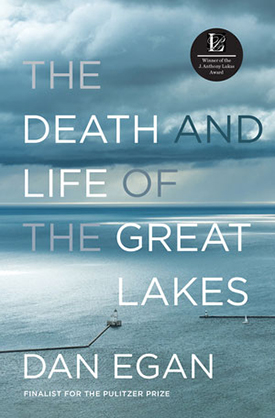
Dan Egan’s book is “The Death and Life of the Great Lakes." (Photo: W.W. Norton & Company, Inc.)
When you think about the number of reservoirs and boat ramps and boats out west and the idea that these people are drawing a line around each water body, doing everything they can to stop a contaminated boat from contaminating the next pond, lake, or reservoir, it's almost an impossible task. Then, if you go across the continent and you look at the boats that have brought in this trouble, every single one of them has to go through this exquisitely tight pinch point. It's called the St Lambert Lock. It's the first lock on the St Lawrence Seaway and it's 80 feet wide. If you stop trouble there, you save a continent's worth of trouble.
CURWOOD: What happens as we go further into this era of human-induced climate disruption, where water is highly variable and we’re going to have a lot of refugees from other parts of America? I'm guessing a lot of these folks are going to head to the Great Lakes, where in a warmer world there's still plenty of water. It’s a lot of folks they need some place to come, and if it's flooded in the coastal areas and if it's dry in the west...
EGAN: Hey, Milwaukee is great. You know, the rust belt could become the blue belt. I think that it's easier for people to move to wet places than for water to move to dry places. The big threat is not people using water along the edge of the lakes. It's people taking water out of the basin because once you take even one drop out of the Great Lakes basin, it doesn't flow back down into the Great Lakes. It flows somewhere else and it’s gone, and enough of those drops, and you get to see the lakes start to shrink.
CURWOOD: Your book is wide-ranging, enjoyably written, and scary in a lot of spots. But as you get towards the end, you do offer up some glimmers of hope.
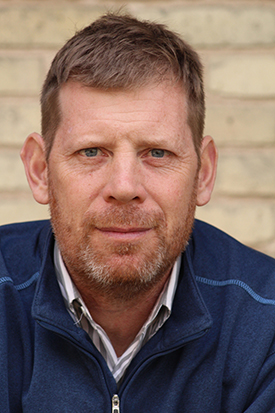
Dan Egan is a reporter for the Milwaukee Journal Sentinel who covers the Great Lakes and the environment. (Photo: The Seminary Co-op)
EGAN: Well, one of the neat things that I think is happening is the lakes are starting to reach some sort of new balance. Zebra and Quagga mussels made it a lake that is not reflective of what it was historically in terms of algae, which is the foundation of the food chain. For years and years that algae just hit a nutritional dead end when it was sucked up by the mussels because nothing could eat the mussels. Well, another wave of invaders came through, and that's the round gobies, and they are little, bug-eyed fish about the size of your thumb, and they are evolutionarily built to eat Zebra and Quagga mussels because they came the same place, the Caspian Sea basin, and they came in the same way, in the ballast tanks of overseas freighters sailing up the seaway. So, the gobies can eat mussels, and mussels are an unlimited energy supply if you can crack those shells and get at them, and the gobies can do that. So, anything that can eat gobis, native species like lake trout, white fish, walleye, are really starting to surge, and they're doing it on the backs of these invasive species.
So the bottom of the food chain looks completely different, but the top is starting to put itself together and looks more like it did 100 years ago than it did anytime in recent history. There's a balance that seems to be emerging, which is encouraging. You say that it's a scary story and it is, and it's a depressing story to a degree, but nature's, you know, obviously resilient, and there are signs that things are getting better for the Great Lakes. I just hope we continue to move in that direction because, you know, healthy fish and clean water and pleasant beaches, that's not a partisan thing, that's just something that everybody likes and should actually demand.
CURWOOD: Dan Egan's book is called "Death and Life of the Great Lakes". Dan, thanks so much for taking the time with us today.
EGAN: Oh, it was my pleasure. Thank you for having me.
Related links:
- The Death and Life of the Great Lakes by Dan Egan
- Dan Egan’s reporting
- Canadian Broadcasting Corporation: Broadcast on the April 25, 1959 Opening of the Saint Lawrence Seaway
[MUSIC: Marcus Roberts, “Cherokee” on As Serenity Approaches]
Purrfect for Cats and Coffee
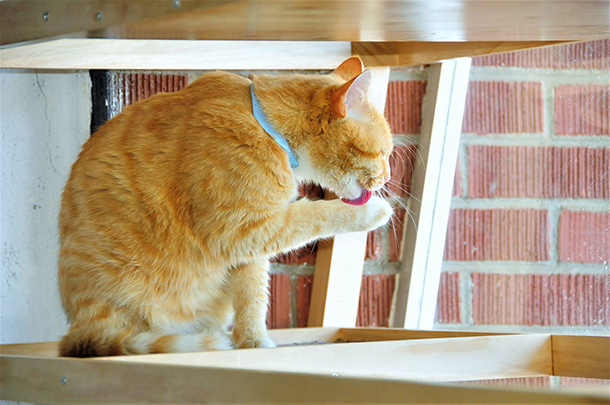
One of the cats that calls Java Cats Café home right now. (Photo: Java Cats Café)
CURWOOD: Cat lovers can be fiercely loyal to their pets, like Sean Powers of Georgia Public Broadcasting who even brings his cat to work! So it was inevitable that when a cat cafe opened in Atlanta, Sean went to check it out and prepared this audio postcard.
WITMEYER: Hey, guys, how's it going?
CUSTOMER: Good. How are you?
WITMEYER: Good. Thanks! If you have any questions, let me know. Most of the cats here have collars on that have their names on them. Blue is male, pink is female. Do you guys have cats at home?
CUSTOMER: Two.
WITMEYER: Awesome, OK. Well, you're good to go. Just have fun.
WITMEYER: My name is Rachel Witmeyer and I'm a cat lounge host here, and my job is to make sure the cats are interacting well with all of our guests and that they have enough food and water and a clean place to use a litter box, and then also to figure out what their favorite toys are.
[MUSICAL NOTES FROM A ELECTRONIC DEVICE]
WITMEYER: That is a meowing piano. [MUSICAL NOTES] He seems to like it.

The coffee lounge area at Java Cats Café in Atlanta. (Photo: Java Cats Café)
[CAT MEOWS]
LOVELLE: Hello! So sweet. I just love cats. [LAUGHS]
LOVELLE: I'm Tina Lovelle. I'm a teacher. I'm wearing a black cat T-shirt. I'm a big cat nerd, so it's right up my alley, no pun intended. I think cats just have a personality, and what I like about them is that you have to get to know the cat to really understand the cat, you know, as opposed to a dog. You know a dog from the get go. This dog is happy and that's the dog, as opposed to, like, it's a person. If you meet someone new, you have to take time to get to know them, and cats are the same way.
[CAT GROWLS]
WITMEYER: This is Olivia. She's been adopted. That's Mama Turnip. She's very unhappy. Would you like a treat? If only I had a video right now. The cat's trying to claw at the window.
MAYO: My name is Brent Mayo. I do field operations, mostly data collection for a technology company.
Right now I'm seeing lots and lots of toys. This is - so people can visualize it - almost like a skate park except for cats. There are ramps, and there are little jumper boards for the cats to go up the walls and diagonally, one board to the next. It's kind of a cat's dream play-scape.
BOT: I used to have a black cat. He liked my roommate more, so I gave him to my roommate. My name's Bridget Bot. It's really cool. I really...It's a different experience. I love cats, and I love coffee, so it's cool for the two to be together.
[ESPRESSO MACHINE HISSING]
MASON: And then once it's at blood temperature, you dunk it to where it's nice and silent and you're just heating the milk to that perfect temperature.
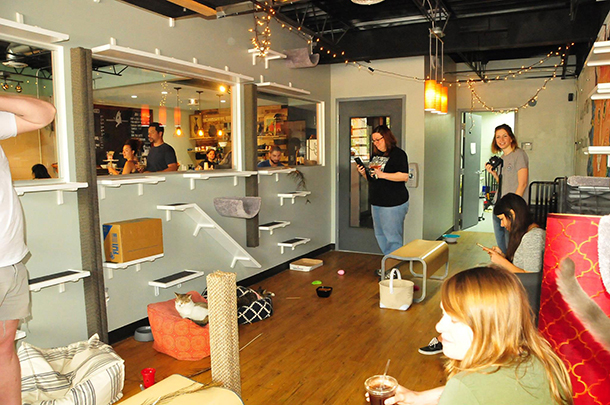
The cat lounge at Java Cats Café features a large play area for the animals. (Photo: Java Cats Café)
[ESPRESSO MACHINE HISSING]
MASON: My name is Chris Mason. I am the certified barista trainer here at Java Cats. My wife was the one that told me about this place. I was going to school and working at a burrito shop, and my wife came up to me to said, "Chris, there's a place that’s serving coffee and cats and you're really good at coffee, and I want a pet cat. So, you need to apply there and get a job."
HILTON: My name is in Hayden Hilton, and I'm the owner of Java Cats Cafe. I just hope in a year from now that we are still successful, still doing a high number of adoptions, that we live beyond the hype. Right now, people are really excited about this new different idea, but I want to be a staple coffee shop in Atlanta, and just people come for the coffee and not necessarily for the cats, or people come for the cats and not necessarily for the coffee, but just be a great coffee shop that is giving back to the community.
CURWOOD: That’s Hayden Hilton, owner of the cat cafe, ending Sean Powers’ audio postcard of this new furry Atlanta attraction.
Related link:
Java Cats Café
[MUSIC: Brittnee Siemon/Candace Dickinson/Marion Sprott, “Duetto buffo di due gatti (Duet For Two Cats)”, live performance recorded 2014, Gioacchino Rossini. Not commercially available.]
CURWOOD: Next time on Living on Earth, lead paint contaminates many old homes, and programs to deal with it are on the chopping block.
PALFREY: The proposition that we cut EPA funding to states for lead poisoning prevention is very shortsighted and doesn't acknowledge the fact that prevention is where we need to be at this point.
CURWOOD: The continuing danger of lead. That’s next time, on Living on Earth.
[MUSIC: Brittnee Siemon/Candace Dickinson/Marion Sprott, “Duetto buffo di due gatti (Duet For Two Cats)”, live performance recorded 2014, Gioacchino Rossini. Not commercially available.]
CURWOOD: Living on Earth is produced by the World Media Foundation. Our crew includes Naomi Arenberg, Bobby Bascomb, Savannah Christiansen, Jenni Doering, Noble Ingram, Jaime Kaiser, Don Lyman, Alex Metzger, Kit Norton, Helen Palmer, Adelaide Chen, and Jolanda Omari. Tom Tiger engineered our show, with help from Jeff Wade and Jake Rego. Alison Lirish Dean composed our themes. You can hear us anytime at LOE.org - and like us, please, on our Facebook page - PRI’s Living on Earth. And we tweet from @LivingOnEarth. I'm Steve Curwood. Thanks for listening!
ANNOUNCER1: Funding for Living on Earth comes you, our listeners, and from the University of Massachusetts, Boston, in association with its School for the Environment, developing the next generation of environmental leaders. And from the Grantham Foundation for the protection of the environment, supporting strategic communications and collaboration in solving the world’s most pressing environmental problems. Support also comes from the Energy Foundation, serving the public interest by helping to build a strong, clean, energy economy, from Carl and Judy Ferenbach of Boston, Massachusetts and from SolarCity, America’s solar power provider. SolarCity is dedicated to revolutionizing the way energy is delivered by giving customers a renewable alternative to fossil fuels. Information at 888-997-1703. That’s 888-997-1703.
ANNOUNCER2: PRI. Public Radio International.
Living on Earth wants to hear from you!
Living on Earth
62 Calef Highway, Suite 212
Lee, NH 03861
Telephone: 617-287-4121
E-mail: comments@loe.org
Newsletter [Click here]
Donate to Living on Earth!
Living on Earth is an independent media program and relies entirely on contributions from listeners and institutions supporting public service. Please donate now to preserve an independent environmental voice.
NewsletterLiving on Earth offers a weekly delivery of the show's rundown to your mailbox. Sign up for our newsletter today!
 Sailors For The Sea: Be the change you want to sea.
Sailors For The Sea: Be the change you want to sea.
 The Grantham Foundation for the Protection of the Environment: Committed to protecting and improving the health of the global environment.
The Grantham Foundation for the Protection of the Environment: Committed to protecting and improving the health of the global environment.
 Contribute to Living on Earth and receive, as our gift to you, an archival print of one of Mark Seth Lender's extraordinary wildlife photographs. Follow the link to see Mark's current collection of photographs.
Contribute to Living on Earth and receive, as our gift to you, an archival print of one of Mark Seth Lender's extraordinary wildlife photographs. Follow the link to see Mark's current collection of photographs.
 Buy a signed copy of Mark Seth Lender's book Smeagull the Seagull & support Living on Earth
Buy a signed copy of Mark Seth Lender's book Smeagull the Seagull & support Living on Earth

